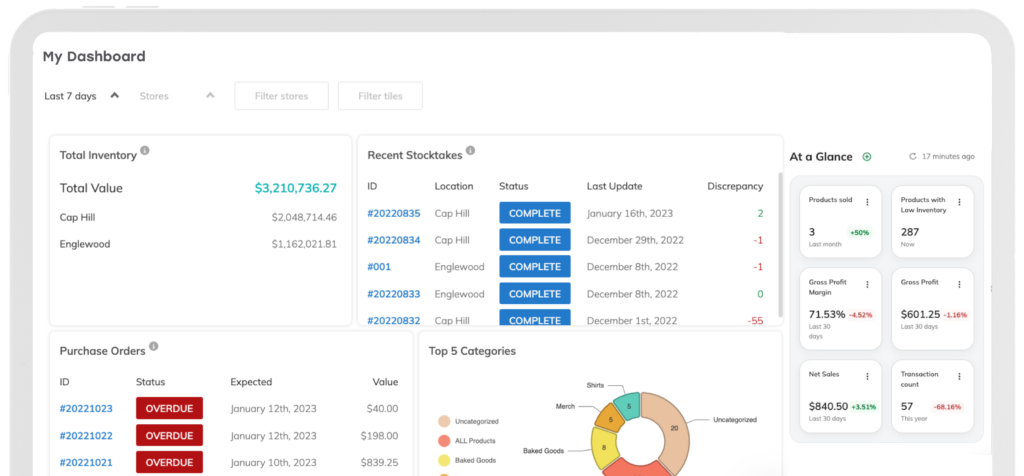
These 15 Small Business Trends Will Dominate 2025
Small businesses don’t exist in a vacuum. Actions that one company takes are often replicated across countless others, and before you know it, that idea becomes a trend. Keep reading to discover the most likely small business trends in 2025, along with tips to stay ahead and replicate other companies’ successes.
Consumer Trends To Watch Out For

1. Self-serve options galore
Self-serve solutions require lots of brainstorming, creativity, and innovation — and it’s all worth it. After all, 81% of consumers are interested in having more self-service opportunities available.
To that end, the self-checkout aisle at the grocery store is only the start of self-serve options that more small businesses should try. Newer self-serve experiences, such as do-it-yourself returns via online portals, are expected to be dominant small business trends in 2025. Self-checkout kiosks — those large tablets you may have seen at McDonalds or Dunkin Donuts — are expected to spread to small businesses as well.
Create any self-serve experiences to capitalize on this trend, as long as your business is reasonably able to sustain it. For instance, if you sell products both online and in-person, offer online customer accounts that include the option to initiate returns for any purchase. Build in technology for users to auto-generate shipping labels and packing slips. Incorporate messaging that lets in-person shoppers know that their returns have been approved and that they should hand the item off to a sales associate at your store.
This kind of streamlining doesn’t replace your staff. Rather, it gives them more time to focus on what really matters — delivering the best customer experience possible. With self-serve options covering the basic tasks, your team is free to answer customer questions and offer personalized recommendations they can only get at your store.

2. Retail apps will become the standard
Mobile apps have become the nexus of customer loyalty for in-person and online retailers alike. Naturally, retail apps will be more than just one of the biggest e-commerce trends of 2025. They’ll also be among the foremost omnichannel trends in 2025.
Of course, developing an app costs a good chunk of money, unless you’ve got an e-commerce store that offers plug-and-play style app integration. The cost is often justifiable since 76% of consumers shop via mobile apps.
Among customers using mobile apps to shop, 46% do so to earn loyalty rewards. In a 2023 study from Scanbot, 70% of respondents even said app loyalty rewards were enough motivation to make them spend more with a retailer. If those customers enable push notifications on your app, give them the opportunity to do exactly that. Send reminders for when their favorite items go on sale or when you receive new inventory that appeals to them based on past purchases.
Consider the example of a boutique dog food business — the kind that advertises itself as selling human-grade food. The company’s products are more expensive than other pet food brands, so customers might seek ways to get discounts. A loyalty program is among the most reliable ways to encourage repeat purchases at lower prices. With the app available right at their fingertips, they don’t even have to leave home to patronize your store, making your business an easy first choice. Plus, given the resulting increase in sales, the cost of developing the app pays for itself.
3. Major investments in sustainability and circular economies
Eco-friendly business practices are expected to stay at the forefront in 2025. Of course, small businesses with sustainable processes drastically reduce their environmental impact, and that in and of itself is an incentive. There’s also a clear business case for retail sustainability: Nearly half of customers prioritize sustainable products in their shopping.
Circular economies are expected to prevail among sustainable small business trends. In this model, a business reuses and recycles its resources instead of buying new materials. A natural first place to start is a recycling program, where customers can return packaging and refill it with your product or get a discount off their next purchase as a thank you for recycling with you.
If your business already has these practices in place, consider taking it to the next level. Let’s say you run a restaurant that runs its dishwashers many times per day. Suppose you also grow your own plants for the kitchen or work with small local suppliers who run small farms nearby. Install a greywater system that saves your dishwasher water for reuse to fertilize these plants, and you’ll be able to tout your sustainable practices while slashing your water bill.

4. Personalization won’t go away anytime soon
Personalization gets named as a small business trend just about every year, and that’s for a reason. Sure, it’s a buzzword that many small businesses fumble, but if you create experiences that deeply speak to each person’s unique needs and interests, its power is undeniable.
Doing so requires personalized data, but the good news is that you likely already have enough information to offer a unique experience. Recent purchase details and demographic data, such as gender and birthday, is typically sufficient for effective personalization. Getting creative with options like personalized buyer guides and online quizzes to find out shopper preferences tell you a lot about your target market.
Design marketing emails customized to each person’s wants and needs — perhaps the single most effective form of personalization in this day and age. Learn to proficiently use third-party marketing tools or free platforms like Google Analytics and Google Search Console.
5. Inspiration will drive purchase journeys
More consumers than ever are heading online with the intent to buy, but without an exact idea of what to purchase. Small businesses that inspire purchases, especially through social media ads and influencers, will excel in 2025. In fact, 62% of Gen Z shoppers visit brands’ social media pages for purchasing decisions.
If you sell college football apparel, reaching your Gen Z audience is often as simple as creating ads that stop people in their tracks. Pay for these ads to appear on your target audience’s Instagram feeds with a concise yet compelling call to action, and you’re providing just the inspiration your customers need. Work with influencers on campus who are willing to appear at a game wearing your t-shirt, or collaborate with school clubs or groups who will roll into a football tailgate in your jackets.
Storefront Trends For Brick-And-Mortar Businesses

1. Multi-hyphenate businesses that combine unexpected pairings
Have you thought about expanding your coffee shop into a coworking space to draw busy professionals to your unique roasts? This business structure, which drives customer acquisition, is known as a multi-hyphenate business.
Small companies offering two or more distinct sets of products or services under the same roof are multi-hyphenate businesses. These businesses will trend in 2025 since they generate multiple revenue streams, drive customer loyalty via extensive offerings, and open new marketing routes for business owners.
2. More efficient checkouts
In the U.S., 46% of people make contactless payments roughly once a week. Small businesses that shore up their infrastructure for accepting contactless cards, Apple Pay, Google Pay, and other mobile payments will thus follow one of 2025’s biggest small business trends.
Contactless payment options offer a uniquely streamlined checkout experience. No more fussing to swipe a card properly or fully insert it into a chip reader — and, in some cases, no card is needed at all. Customers will simply take out their mobile devices, enter their passcode, and tap against your contactless card reader for an instant payment that’s also more secure.
What’s In Store For E-Commerce In 2025
1. Showrooming (a.k.a “endless aisles” or “low-inventory stores”)
Think about all the online businesses you’ve seen open brick and mortar locations, like Warby Parker eyewear or Indochino suits. Have you noticed that, in many real-life versions of e-commerce operations, consumers browse products themselves and ask an employee for help if needed? This balance between a self-guided experience and the setup of traditional physical stores is the heart of showrooming, which will rank among the most prominent retail trends in 2025.
Showrooms are an incredibly cost-effective approach for e-commerce platforms who wish to center in-person marketing through product interactions. For example, if you sell running shoes online, expand your digital presence with a small showroom where customers try on and test out whichever shoes they want. Keep some employees around to guide customers with hands-on expertise as part of the shopping experience. You’ll give your online audience a way to try before they buy without the hassle of a return program, and that alone is a huge revenue driver.
2. Fast, free shipping — or local delivery
You’ve probably noticed from your own experience as a consumer that free shipping is becoming much more common, along with significantly faster shipping time frames. More small businesses are expected to embrace this trend in 2025.
To meet this consumer demand, you’ll need to spend less on shipping. Flat-rate shipping, lower-weight packages, and local delivery programs are all potential solutions. The latter is especially new and powerful for e-commerce platforms — find a brick-and-mortar store in your area to partner with, and you’re all set. Or, hire delivery drivers to get your products into local buyers’ hands.
For example, suppose you’re running an e-commerce hat store out of your apartment in Sherman Oaks, California. You might be shipping all over the country, but you also might be shipping to other parts of the Los Angeles County area. Take a trip into Echo Park or Los Feliz and look for cool, hip apparel stores that could be pickup spots for your L.A. customers outside of the San Fernando Valley. Make a few trips a week to this store, drop off your east side orders, and neither you nor your customers will pay for shipping. Plus, your customers will get your products sooner.

3. Offering product subscriptions for efficient reordering
Beauty products, among others, run out quickly, and customers might only realize they need to re-up once they’re out of your product. This challenge is why product subscription models have revolutionized the e-commerce space and will be among 2025’s leading e-commerce trends.
When, for example, a customer sets the razor head for their electric shaver to arrive every four weeks, a smooth, clean shave is always guaranteed, as is income for your hair care company. This streamlined, hands-off way to achieve steady revenue is excellent for growing your small business.
Omnichannel Innovations To Test Out In 2025
1. Hybrid shopping: the best of both worlds
Hybrid shopping sits high on many lists of omnichannel trends for 2025. Showrooming is among the most common hybrid models, as is ordering online for curbside pickup. Similarly, when larger brands offer the option to ship an item from a warehouse to a local store for pickup, that’s hybrid shopping.
In a way, these models qualify as multi-channel selling too. The initial order happens online, and during pickup, the customer gets to browse your in-person location to discover new products and potentially make a purchase. For example, a music store could sell some of its guitar pedals for online order and local pickup, then deck out a wall of the in-person location with pedals not available online.
2. Experiential shopping for deep customer connections
Pop-ups, in-store samples, and events are all part of experiential shopping strategies. These activations stem from customers seeking real-life brand interactions in a time of omnipresent digital marketing. After all, customers can’t try your tea brand’s premium sachets online. A pop-up at which customers get to brew tea, however, lets them experience your tea blends for themselves. From there, a purchase becomes more likely, so experiential marketing will almost certainly trend among small businesses in 2025.
Marketing Trends Everyone Should Know About
1. Using Artificial Intelligence (AI) to optimize workflows
Instead of using AI to take over tasks entirely, small businesses should leverage this technology to optimize workflows in 2025. To do so within your business, pinpoint your most repetitive tasks, identify several AI tools capable of completing these tasks for you, and test how each tool performs. Integrate each tool with all your others while testing so that AI exists naturally within your workflows. Consider:
- Trello for rule-based automations that replace repetitive tasks, such as letting your team know when you’ve completed your part on the upcoming email blast, in your project management software
- ClickUp Brain for gathering data on businesses like yours for competitive analysis
- Inventory management platforms, such as Thrive Inventory, or POS systems that auto-generate SKU numbers for each product you sell
The idea is to leverage artificial intelligence to save time on the tedious parts of a process and let your team handle the most important and exciting parts.

2. Abundant social sharing opportunities
Among customers who fall into the Generation Z age bracket, 40% encounter new products on social media, with a strong preference for new products discovered through Instagram Reels or TikTok videos. Given social media’s eternal grip on the retail world, small businesses creating opportunities for social sharing and discovery will rank among 2025’s most prominent small biz trends.
Suppose you sell crocheting kits for beginners and want to reach social media users who are newly exploring this creative outlet. Upload short Reels or TikTok videos showing your kit in action, with the requisite subtitles and quick pacing. Focus equally on your kits’ ease of use and the stunning designs people create with them. The former attracts customers in the first place, and the latter makes your content more likely to get shared on social platforms. And with more shares come even more attracted customers.
3. The sharing economy (it’s different than social shares)
What if, instead of selling products and constantly buying new stock, your business could rent its products out instead? This idea drives the sharing economy, which will trend in 2025. In the sharing economy, people rent what they own to other people (or businesses) for a price less than the full sale price.
Small businesses benefit in two potential ways. They access items at a lower cost, or they seize the moment and build a marketplace where people rent to each other.
For example, maybe your coffee shop is looking to expand in unorthodox ways. One idea is to buy home roasting machinery that, when not in use for in-store roasting, you rent to other small coffee shops. Or, collaborate with customers who have home roasting machinery to create an online marketplace where these customers rent their equipment to excitable first-timers. Take a cut of each rental, and let the customer keep most of the earnings.
Staying On Trend In 2025
From experiential shopping that makes buying an adventure to more sustainable business practices, 2025 offers a wealth of possibilities for your operations. Keep up with these trends and observe others forming, then strategize how to incorporate them into your business. You’ll attract new customers, retain your existing ones, and build relationships that weather out trends in 2025, 2026, and far beyond — a great future lies ahead.
The Newsletter For Small Businesses
Weekly expert insights, industry trends, and inspiring stories designed to help you run your business with confidence.
The Only Inventory System That Actually Helps You Run A Healthy Business
Thousands of customers all over the world use Thrive Inventory to run a healthy business.
Thrive Inventory gives you control over all your inventory, sales channels, and metrics, allowing you to make the right decisions at the right time.
Keep Reading

The Newsletter For Small Businesses
Weekly expert insights, industry trends, and inspiring stories designed to help you run your business with confidence.
Try Thrive Inventory For Free
Add Thrive Inventory to your business and maximize your potential. With powerful and easy-to-use products, it’s time to take control of
your business and see what you can do with Thrive.




